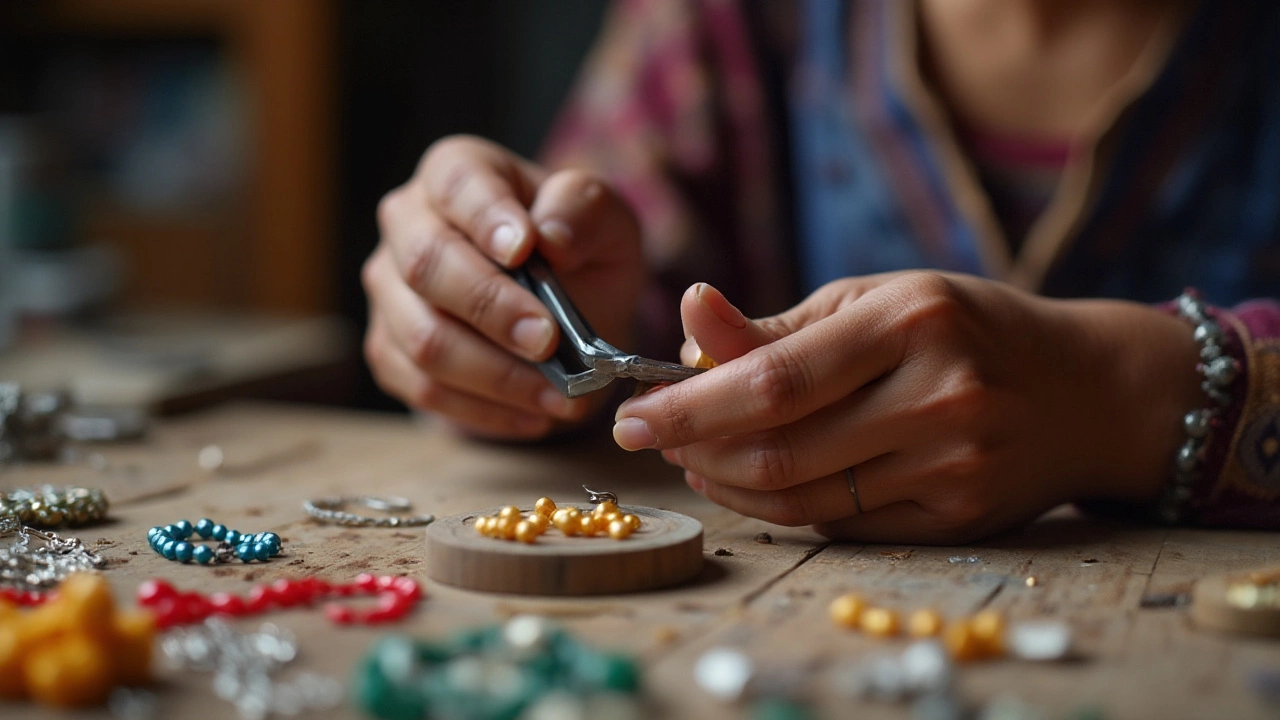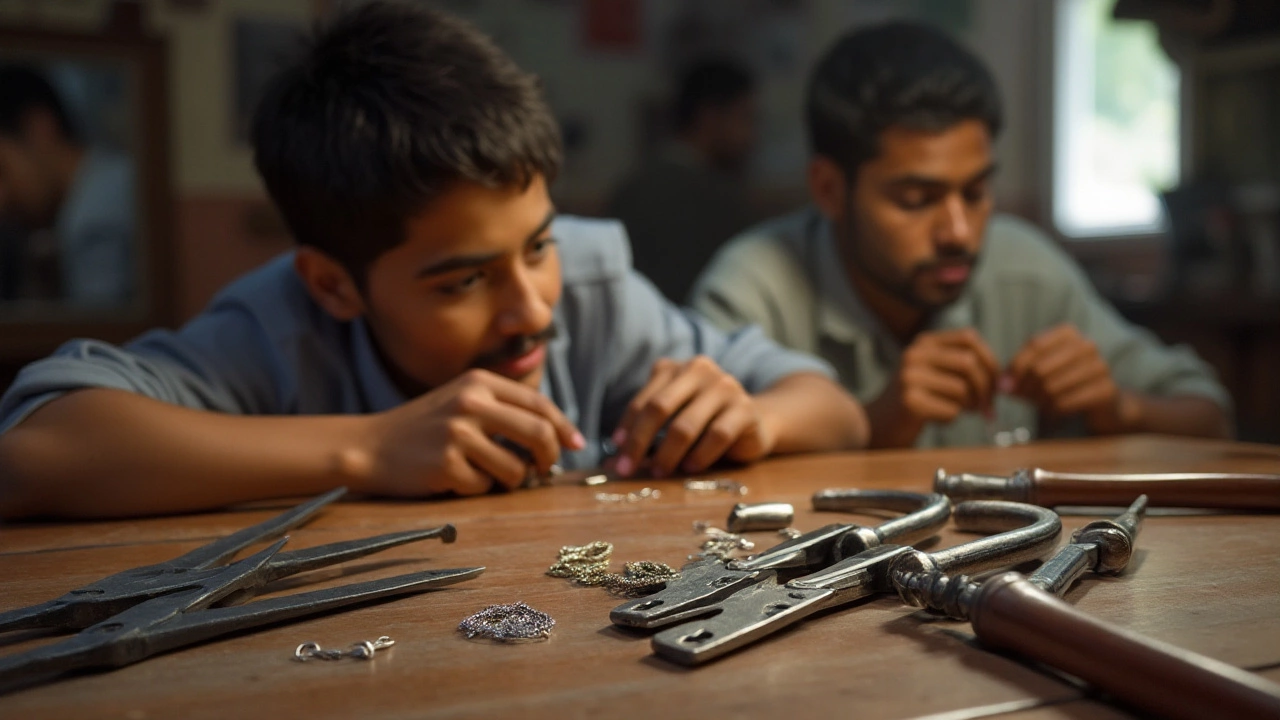
In the world of jewelry making, jump rings are incredibly important. These small metal rings function as the connections between various elements of a piece. Whether you're crafting necklaces, bracelets, or earrings, the ability to effectively open and close jump rings can make a significant difference in the strength and appearance of your creations.
While it may seem like a simple task on the surface, using the right tools and techniques can ensure that your work not only lasts but also looks professional. This guide will explore the tools you need, share helpful strategies, and suggest handy tips for working with jump rings in your jewelry projects.
- Understanding Jump Rings
- Essential Tools for Jump Rings
- Techniques for Opening Jump Rings
- Techniques for Closing Jump Rings
- Tips and Tricks for Jewelry Makers
Understanding Jump Rings
Jump rings are the unsung heroes of the jewelry making world. Typically, these tiny loops of metal serve as connectors in various types of handmade jewelry, binding together elements like clasps, charms, and beads. Available in a variety of sizes, thicknesses, and materials, a well-chosen jump ring complements the aesthetic and secures the overall structure. Deciding which to use is no small task; factors such as gauge, internal diameter, and metal type all need careful consideration. The most common materials for jump rings include stainless steel, which is revered for its durability, and sterling silver, favored for its elegance. Each type brings something different to the table, influencing both the design and function of the finished piece.
Delving deeper, it's worth noting the importance of wire gauge when selecting jump rings for your projects. The gauge of a wire essentially refers to its thickness, and this, in turn, affects the strength of the jump ring. A lower gauge means a thicker wire, providing more durability, which is essential for supporting heavier pieces like chunky bracelets or necklaces. On the flip side, a higher gauge offers more flexibility and is ideal for delicate components. Sizing the diameter correctly also demands attention, since it determines how snugly pieces will fit. A ring that's too small can cause undue tension and wear, while one that's too large may not secure parts effectively. As any seasoned jeweler will attest, this nuanced selection process plays a pivotal role in the work’s longevity and allure.
A fascinating aspect of jump rings is their versatility, extending beyond mere connectors. Some jewelry makers seek innovative designs by overlapping rings in creative patterns, known as chainmaille, a technique that traces back centuries. Chainmaille not only offers intricate and visually striking designs, but also brings an added layer of strength and texture. Historical records even reveal that chainmaille was used in armor design in medieval times, which speaks volumes about its strength and flexibility. This ancient technique, once used for protection, has transitioned beautifully into modern fashion, showing that old-world practices can find renewed purposes in contemporary art forms.
"Jump rings are like the punctuation marks of jewelry design; they quietly provide structure and clarity without drawing attention to themselves," notes Renowned Jeweler Alex Monroe in his workshop chronicles.
The history and application of jump rings represent the vast possibilities within the realm of handmade fashion accessories. For those entering the vibrant world of jewelry making, gaining a robust understanding of these vital components can transform an amateur into a proficient creator, capable of crafting pieces that not only display personal identity but also withstand the test of time. Whether you're using them as links, pendants, or decorative elements, mastering the art of working with jump rings is an invaluable skill that facilitates endless creative potential.
Essential Tools for Jump Rings
When diving into the creative world of jewelry making, especially when working with crucial pieces like jump rings, having the right set of tools can be transformative. At first glance, these rings may seem insignificant, but they play a key role in ensuring the integrity and aesthetic appeal of your pieces. For anyone serious about crafting, investing in quality tools is a non-negotiable step. The first must-have in your toolkit is a pair of flat or chain nose pliers. These pliers are distinguished by their smooth, flat surfaces that make gripping and manipulating small metal parts like jump rings a breeze without scratching them. As a versatile choice, they can also be used for bending and flattening wire ends, making them indispensable.
Next, consider adding bent nose pliers to your arsenal. These are akin to the chain nose, yet they have a uniquely angled tip that provides much-needed leverage in tight or awkward spaces. The angle allows for more precise manipulation of jump rings, especially when attaching charms or intricate details to a piece. There's a certain elegance in how they prevent your hands from blocking your view of your work. Moreover, should you find yourself working with particularly thick or tough materials, the trusty round nose pliers might become your best friend. Their robust, rounded jaws make loops and curves simpler than ever. When precision is essential, this tool can offer the exacting control that every jeweler desires.
A pivotal tool for those aiming for precision and minimizing hand fatigue is the jump ring opener. It's a simple yet innovative tool worn on the finger like a ring, equipped with slots to hold a variety of sizes of jump rings. This provides stability while keeping your other hand free to work, significantly speeding up the process. Some artisans swear by it for bulk projects, as its ergonomic design reduces repetitive strain injuries which are common among frequent jewelry makers. According to jewelry designer Lisa Yang, "The right tools are not just a convenience—they are an extension of your creative vision."
Using inadequate tools usually results in a frustration rather than a masterpiece," she adds.
In your toolbox, you'll also find a range of additional supportive measures to aid your craftsmanship. For instance, a magnifying lamp hangs as a guardian over precision work. It’s perfect for periodical checks to ensure that every jump ring is closed tightly and align perfectly with the overall design. Equally, a jeweler's bench should not be underestimated. Providing both a stable platform and tool storage, it is where your creations come together to form something truly beautiful.
The Value of Investing in Quality
Quality matters. There's something incredibly satisfying in working with tools that feel weighty and well-constructed, each fitting comfortably within your hand. They can make crafting not only easier but also more enjoyable. By investing in sturdy, reliable tools, you're setting yourself up for success. As your skills develop, you'll quickly notice the difference these investments make not only in the quality of your work but also in the fluency and speed of your process.
All these essential tools for managing jump rings live under a single philosophy—control. Whether you're a newcomer or have been designing for years, the right tools empower you to focus on what truly matters: translating your ideas into beautiful and simplistic works of art that others will cherish. A combination of chain nose pliers for opening, bent nose pliers for closing, a jump ring opener for managing multiple rings in bulk, alongside the security of a magnifying lamp and workbench, will have you well prepared for the intricate dance of jewelry creation.

Techniques for Opening Jump Rings
Opening a jump ring may seem straightforward, but mastering this skill requires both finesse and the right technique. For any jewelry maker, understanding how to manipulate these tiny connectors is crucial. The first step is to ensure you have the proper equipment at your disposal, such as the indispensable chain nose pliers. These specialized tools have a smooth, flat surface that can grip the ring without causing damage, which is essential for maintaining the integrity of your jewelry pieces. When selecting a chain nose plier, always look for those with tapered ends as they provide better access to small rings, allowing you to maneuver eloquently around intricate designs.
The essential technique hinges on how the ring is manipulated. Unlike opening a ring in a stretching motion, where it loses its circular form, the goal here is to twist the ends. Grip one side of the jump ring with a pair of pliers, and then use another pair for the opposite side. While holding firm, twist one hand upwards and the other downwards in a gentle, controlled motion. This approach helps maintain the ring's perfect loop, ensuring an unbroken circle when closed again. A common mistake that beginners make is using their fingers for twisting, which often results in bent and weakened rings that may not properly align when closed.
Utilizing two pliers simultaneously also offers added control. However, if you're a beginner, it can be quite tricky at first, so don't rush yourself. Takes practice to develop this skill. In fact, according to renowned jewelry maker, Mary Jane Dodd, "The patience you put in mastering the use of pliers will reflect in your pieces' robustness and allure—a testament to one's craftsmanship."
Mastering this technique is no different from learning a new craft altogether; perseverance is the key.Moreover, seasoned artisans often recommend practicing on larger jump rings before advancing to the smaller, more delicate ones.
For added precision, some jewelers prefer the bent nose pliers—these have a slight angle, making them perfect for working in tight spots or when creating multi-layered jewelry. They offer enhanced access to jump rings within a design without disturbing other components. Using bent nose pliers can create a leverage point, which makes opening these rings smoother and more controlled. Given the frequency of opening and closing, it's imperative that each action is performed precisely to ensure the ring remains sturdy and aesthetically pleasing.
Lastly, for those ventures into more rugged designs or working with thicker jump rings, consider using parallel pliers. These pliers allow for an even distribution of pressure, which prevents the risk of distortion irrespective of the ring's thickness. With thicker rings, some jewelers prefer employing a magnifying lamp for better visibility. This tool helps illuminate and enlarge the ring details, aiding in more precise handling, particularly if your projects involve very minute jump rings. Remember that every jump ring alteration impacts the final piece, so striving for precision from the get-go is crucial.
Techniques for Closing Jump Rings
Closing jump rings is an essential skill every jewelry maker should perfect for durable and attractive designs. When working with jump rings, precision is key. One of the fundamental techniques involves using two pairs of pliers. Typically, these would be chain nose or bent nose pliers because of their strong grip and ability to work in tighter spaces. You’ll hold one side of the ring with one set of pliers while using the other to guide the closure. This process prevents distortion of the round shape, ensuring a seamless and secure closure.
There is an art to it, really. Begin by ensuring that the ends of the jump ring are perfectly aligned. When pulling the ends back together, a gentle movement is key. Imagine a door hinge; you’ll want to create the same kind of motion. It's a slight back and forth tight motion until they meet perfectly without overlapping. It’s fascinating how a steady hand and patient demeanor can turn this seemingly mundane task into a zen-like practice. Remember, each jewelry piece you make holds character and craftsmanship, hinging delicately on how well these rings are closed.
Consider the material of your jump rings as well. Softer metals, like sterling silver or copper, require a gentler touch, while harder metals, such as stainless steel, might need a firmer grip. This is a nuanced area where checking the tension can make all the difference. A popular tip among veteran jewelry makers is to slightly over-close the ring before maneuvering it back into place, creating a natural tension as it snaps shut. This small adjustment can make your connection points last longer and withstand more wear and tear, especially in pieces designed to hang.
The Craft Council of Jewelry Enthusiasts states: "The power in jewelry making lies in the details—starting from how one manipulates the smallest parts like jump rings.”
For those who yearn for perfection, using a magnification tool can help see the tiny gaps that might not be visible to the naked eye. This extra step is especially important when constructing elaborate or high-value pieces where attention to detail significantly counts. Another insider tip is to have a well-lit workspace, possibly a direct source of light that helps you spot any imperfections quickly. True artisans take pride in knowing that these meticulous methods become second nature with practice; and there is a special satisfaction that comes only when everything clicks perfectly into place.
Some jewelry makers turn to specialized techniques, like soldering, to permanently secure jump rings. Though this technique requires additional tools and skills, it provides absolute security and is often used in high-end pieces. Soldering involves heating the jump ring and using a small amount of metal alloy to connect the ends permanently. It's a complex method but ideal for substantial jewelry pieces where the durability of the connection is non-negotiable. This technique assures that your connections remain sturdy even in the face of potential stress and use.

Tips and Tricks for Jewelry Makers
Jewelry making is an art that requires both precision and imagination, and working with jump rings can certainly test these skills. So how does one go about mastering these tiny yet pivotal components? First and foremost, it’s vital to use the right tools—a lesson every seasoned jewelry maker will echo. Many experts recommend a pair of chain nose pliers for their versatility and ability to reach into tight spaces. These pliers come in handy when you need an extra bit of control over the small metal rings, allowing you to open and close them with ease. Another tip is to consider investing in a pair of bent nose pliers, which often provide better angles for maneuvering jump rings without straining your wrist or fingers.
Working effectively with jump rings is all about technique. As you engage in your craft, remember to always twist your jump rings open—never pull them apart. This protects the circular integrity of the ring and helps ensure a secure closure. A good habit is to hold the jump ring on opposite sides with two pliers, twisting one hand forward and the other backward. With practice, this becomes second nature and efforts to maintain a seamless finish pay off. Remember the adage, 'a little twist goes a long way,' and you'll find this small adjustment makes a big difference in the quality of your jewelry.
"Precision is to craftsmanship as imagination is to artistry. Both hands need to meet at the middle fingertip," wrote renowned jewelry designer Adella Brennan, reminding us of the synchronized dance that goes on at a workbench.
Don’t underestimate the power of organization in your crafting area—especially when dealing with jump rings. Having a designated workspace where your tools are within arm’s reach, and your materials neatly sorted, can dramatically reduce assembly times. Using a simple pillbox system for jump rings can prevent losing track of sizes or types. Additionally, pre-planning your designs by sketching them out can help visualize the placement of jump rings and allocate your time more effectively.
Finally, seeking inspiration never hurts. Whether that means attending workshops, joining online jewelry-making forums, or engaging with a vibrant community on social media, connecting with fellow artisans can yield new ideas and techniques. Consider how veteran makers transform simple practices into artful twists and turns—literally. You might even stumble on a trend, like the current popularity of mixed metal looks, which you can bring into your own projects.
| Tool | Function |
|---|---|
| Chain Nose Pliers | Versatile, precise grip for small parts |
| Bent Nose Pliers | Use for better angles and control |
| Flat Nose Pliers | Simpler for basic grip and movement |
In the ever-evolving realm of jewelry making, learning to work proficiently with jump rings is an essential skill. Keep these tips and tricks at your disposal and hopefully, they'll help streamline your process and enhance the quality and appeal of your intricate pieces. With practice and patience, you'll find that these little loops of metal hold a world of potential.


